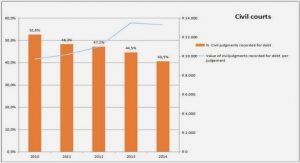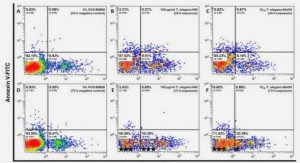Get Complete Project Material File(s) Now! »
Chapter 3. Atmospheric Water Budgets and Variations of Moisture Flux Divergence over the Southwest Pacific
Literature review
Knowledge regarding the characteristics of horizontal moisture transport is crucial to the understanding of the global energy and the hydrological cycles. From a water balance perspective, this is because the vertically integrated moisture flux divergence (MFD) provides a useful diagnosis of the difference between evaporation (E) and precipitation (P) (Trenberth et al., 2011). Although in theory moisture flux convergence over land should be balanced by river runoff, this is rarely the case in observation data as there are significant uncertainties in the observations of all variables (P, E and river runoff). More importantly, divergence and convergence of moisture flux are key features within storm systems that account for much of the P variability in the mid-latitudes. Given that the statistical properties and spatial patterns of P is likely to change in warmer climate (Chou et al., 2009; Seager and Vecchi, 2010; Bony et al., 2013), and accurately projecting P has been a longstanding challenge, it appears that we have much to gain by thoroughly investigating MFD, both in itself and as a control on P.
In spite of improvements in many aspects, current observations and reanalyses have not yet achieved a closed atmospheric water budget (Trenberth et al., 2007; 48 Andersson et al., 2011). For example, Park et al. (2013) found that the residuals of water budget components over the global ocean as estimated from satellite, blended, and reanalysis data are not negligible and thus warned that caution is needed when applying these datasets to quantitative water budget studies. Lorenz and Kunstmann (2012) identified a sudden shift in the model-based P – E from MERRA and CFSR in 1998. In both cases, they attribute this to an artificial increase in oceanic precipitation which is caused by the assimilation of sounding radiances from AMSU-A on the NOAA-15 satellite. In contrast, MFD from the chosen reanalysis products agrees well with each other and appears to be quantitatively sound. The study also concludes that the largest imbalance is over the oceans. Brown and Kummerow (2014) quantified the imbalance of the atmospheric moisture budget over the western Pacific Ocean is 21%. In a study that examines the water budget components from eight reanalysis products, Trenberth et al. (2011) remarked that these products ‘mostly disagree and are unreliable, violate basic physical constraints, and probably should only be used after demonstrating their validity (pg., 4921)’.
As can be inferred from the paragraph above, the imbalance is mainly a result of poor measurements of the water budget components in space and time. Precipitation has been measured regularly in many parts of the world where population density is high. Yet there is a scarcity of measurements over mountainous areas or the global oceans. Moreover precipitation in the tropics has been a longstanding challenge due to difficulty for the GCMs to reproduce sub-grid scale convective processes.
Evaporation is probably the most uncertain component of the three, because it is rarely measured, but instead derived from physical or statistical models which can vary greatly in their estimates (Abtew and Melesse, 2012; Harding et al., 2014; Miralles et al., 2011; Ghilain et al., 2011; Trambauer et al., 2014; Mueller et al., 2011). Simple models require fewer inputs (either variables or parameters) with the likely compromise on accuracy. Conversely, complex models require more inputs, and as such may be limited in its utility. A study by Park et al. (2013) found that the correlation coefficient between the most similar evaporation products is 0.72, and the least agreeable pair has a correlation coefficient as low as 0.29. At the regional scale, the inter-product agreement will be even lower, leaving much to be desired. To reconcile the difference, a global network of benchmark evaporation measurement and a multi-dataset analytical procedure are clearly needed to improve the quantification of the hydrological cycle.
Compared with precipitation and evaporation, previous research indicates that estimates of moisture flux divergence appear more credible (Lorenz and Kunstmann, 2012; Newman et al., 2012). Therefore, the computation of freshwater flux using and fields should be superior over P – E. Nevertheless, uncertainties in estimated moisture flux divergence still exist. Smith and Kummerow (2013) show that annually accumulated moisture flux divergence from the latest three reanalysis products – ERAI, CFSR and MERRA – display large discrepancies, in that whether the upper Colorado River basin as a whole is a source or a sink remains inconclusive based solely on the divergence component. Despite so they verify that ERAI is the most credible of the three by examining the E – P.
Atmospheric water storage ( ) is the smallest component of the main water reservoirs of the global hydrological system. Variations in occur as a result of the annual cycle in temperature as well as natural events of large influence such as ENSO events and the Mount Pinatubo eruption in 1991 (Trenberth and Smith, 2005). Global and regional trends in have been reported by a number of studies (Zhai and Eskridge, 1997; Mattar et al., 2011) and the convergence of evidence suggests this to be the case. Trenberth et al. (2005) and Mieruch et al. (2014) found that the trends derived from different products are generally positive over the oceans. However many researchers have emphasized that the quality of the datasets is far from ideal (Zveryaev amd Chu, 2003). A much longer time series is also needed to obtain stable patterns of trends.
MFD can be decomposed in two ways, either based on frequency of variation or contributions from the thermodynamical (moisture related; ) versus dynamical components (wind related; ). Holman and Vavrus (2012) found that the simulated enhancement of the total moisture flux convergence over Madison, Wisconsin by the late twenty-first century is a consequence of the doubling of advection ( ∙ ) and moderate increases in convergence ( ∙ ). Wang et al. (2013) studied variability of MFD in the Intra-America Seas and the western tropical North Atlantic from seasonal to multidecadal time scales. They found that the dynamic contribution has a larger magnitude than the thermodynamic contribution on all time scales. The study by Seager et al. (2007) presents model projections of changes in MFD in southwestern North America. It shows that changes in MFD can be decomposed into the climatological circulation, operating on changes in the climatological humidity, and the atmospheric humidity climatology, operating on changes in the mean atmospheric circulation. While 51 the former reinforces the existing patterns of MFD, the latter leads to reduced mean moisture convergence at the northern edge of the subtropics.
The synthesis of existing knowledge on atmospheric water budget and MFD has presented us with more questions than answers. The first objective of this study is to evaluate the closure of the budgets using a variety of reanalysis, observational and merged datasets, and to quantify the uncertainties in the estimates of E – P. The second objective is to decompose MFD into various components and document climatology, seasonal cycle, interannual fluctuation as well as trends of MFD. The study focuses on the Southwest Pacific (SWP) region and the period 1979-2012. Section 3.2 introduces the data, methods and computational procedure. Section 3.3 presents results regarding the research objectives stated above. Discussion and conclusions are given in section 3.4.
Data, methodology and computation
The study takes advantage of a number of data sources, and a summary of them is given in Table 3.1. Three evaporation products – reanalysis-based E from the European Centre for Medium-Range Weather Forecasts Reanalysis Interim Project (ERAI), satellite-based E from the Hamburg Ocean Atmosphere Parameters and Fluxes from Satellite Data (HOAPS) and the hybrid E estimation from the Objectively Analyzed Air-sea Fluxes Project (OAFlux) – have been chosen. Precipitation datasets are satellite and rain gauge based Global Precipitation Climatology Project (GPCP), and the satellite, rain gauge as well as reanalysis based Climate Prediction Center Merged Analysis of Precipitation (CMAP). Regarding MFD, data from both ERAI and the National Centers
Chapter 1.Introduction
1.1 The atmospheric water cycle
1.2 Research questions
1.3 Outline of this thesis
Chapter 2.Tropospheric Moisture in the Southwest Pacific as Revealed by Homogenized Radiosonde Data: Climatology and Decadal Trend
2.1 Literature review
2.2 Data
2.3 Homogenization procedure
2.4 Results
2.5 Discussion
2.6 Conclusions
Chapter 3.Atmospheric Water Budgets and Variations of Moisture Flux Divergence over the Southwest Pacific
3.1 Literature review
3.2 Data, methodology and computation
3.3 Results
3.4 Discussion and conclusions
Chapter 4.Dynamical Drivers of Extreme Moisture Flux Divergence, and Relationship to Precipitation over New Zealand
4.1 Literature review
4.2 Drivers of precipitation variation in New Zealand
4.3 Data and methods
4.4 Result
4.5 Discussion and conclusions
Chapter 5.Discussion and concluding remarks
5.1 Tropospheric humidity as measured by radiosondes
5.2 Issues in the estimate of atmospheric water budgets
5.3 Characteristics of moisture flux divergence
5.4 Moisture flux divergence as a vital control on precipitation variability
5.5 Summary
5.6 Future work
GET THE COMPLETE PROJECT
Analysis of the Atmospheric Water Budget over the Southwest Pacific






